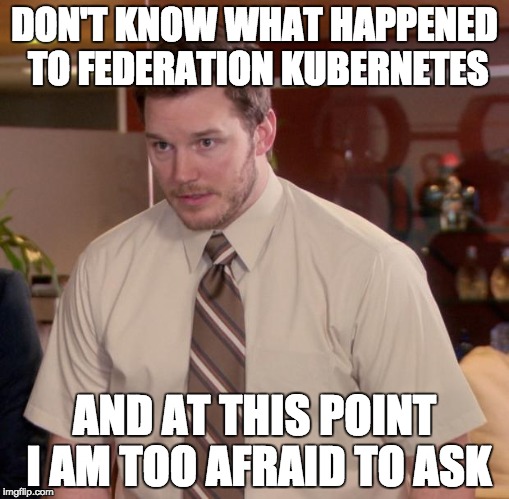I’ve been involved in Kubernetes for a year and a half now. I have been drinking from a fire hose, trying to understand all things Kubernetes - the community direction, the proposals, the current solutions, the good, the bad and the ugly. With so many Special Interest Groups (SIGs) and such a broad community iterating so rapidly, I have come to realize this scope of project is hard for most individuals to have a deep understanding in every area. Considering this, I have tried to keep a “broad, but shallow” understanding of the project by attending the weekly community meeting and Kubecon. But recently I wanted to get a “deep” understanding of a specific part of the Kubernetes ecosystem: Cluster Federation.
Federation was always an interesting concept to me, but I had never explored beyond the initial concept of: “it’s a magical way to control multiple kubernetes clusters - potentially in multiple cloud providers and on bare metal and move workloads throughout the cluster federation”.
As a disclaimer I should say, I do not consider myself a Federation “expert”. The following information is the result of about three weeks of experimenting with the Federation project, attending SIG meetings, watching old conference videos and reading blogs. I would encourage you to do your own research and get involved with the SIG Multicluster - they are super awesome and inviting in my experience.
Over the last 18 months I felt the community went from super stoked about Federation to radio silence. So what happened?

I decided to go on an exploration into the past, present and future of the project formerly known as Ubernetes to try and understand the current state.
The Community
To begin I wanted to go back in time, to understand the initial pitch and subsequent hype around the concept. I focused on conference videos and blogs from 2016 or later. These resources captured what I learned to be the “v1” phase of the Federation project. <iframe width="560" height="315" src="https://www.youtube.com/embed/pq9lbkmxpS8" frameborder="0" allow="autoplay; encrypted-media" allowfullscreen></iframe>
Also reading through the initial proposal will give you an idea of the federation problem space and scope: Kubernetes Cluster Federation (previously nicknamed “Ubernetes”): Requirements Analysis and Product Proposal.
After wrapping my head around the origins of the project, I started learning about the massive changes and shifts that happened around the project in 2017. Here is a list of the highlights:
- The Federation project was incubated in the kubernetes/kubernetes project and released with Kubernetes v1.3.
- Ubernetes project renamed to Federation (more functionally descriptive)
- Federation moved from Kubernetes/Kubernetes to Kubernetes/Federation in v1.9
- The SIG Federation renamed to Multicluster
- Kubefed introduced: A CLI tool to spin up Federation control plane
- “V1” of the federation problem was deemed “problematic” (my probably over-simplified understanding of why being: v1 was a monolithic “Kubernetes on Kubernetes” API, too closely resembling the single-cluster Kubernetes API, forward work would create a tangential and confusing meta orchestration layer)
- “V2” conceptualized with more of a microservices approach, offering components that facilitate federation with a multicluster approach
- SIG Multicluster released new projects: Cluster registry & KubeMCI
So looking back - what happened? Federation was proposed with an agenda in line with Kubernetes in general - abstracting the infrastructure away and creating a world where anyone can deploy anything, anywhere! Ironically in this pursuit of simplicity, Kubernetes (and Federation) have the potential to turn into a hulking monster of complexity. When Federation tried to essentially layer Kubernetes on Kubernetes - the potential for creating a two-headed monster was too real for many people in the community to accept. As a result, the Federation team went back to the drawing board to imagine a more loosely coupled, flexible solution.
Kelsey Hightower’s keynote on Federation from Kubecon in April 2017 captures a more toned-down approach to Federation:
To get a more detailed outline of the current state of SIG Multicluster check out this document: SIG Multicluster - Project Status
Trying the Project
Not only did I want to understand the community dynamics and politics behind the project, I also want to learn how the project works. My preferred method of learning - dive in! I used several tutorials and projects as learning tools, each illuminating a different part of the Federation project for me. Depending on your familiarity with Kubernetes, I suggest completing the following tutorials, once or several times. If you are anything like me, new concepts will start to make sense with each pass.
I started with Kelsey Hightower’s “Cluster Federation (the Hard Way)”. Kelsey’s “hardway” tutorials are a great way to pop open the hood and poke around. He provides instruction to spin up a cluster Federation without using tools like Kubefed, which can obfuscate some of what is going on behind the scenes.
After doing Federation “the hardway” I followed the K8s community guide to setting up a cluster Federation using kubefed.
After these exercises I still one outstanding curiosity: to experiment with multi-cloud Federation. I had the best luck setting up multicloud Kubernetes Cluster Federation with this tutorial: Pac-Man Application On Federated Kubernetes Cluster Across Multiple Public Cloud providers.
I’m not gonna lie…I was feeling pretty godlike successfully coordinating multiple clusters on AWS, Azure and Google Cloud! My goal of seeing a cluster federation working across multiple clouds was realized. I have to extend a big thanks to the SIG Multicluster members for answering quite a few questions and recommending great resources. I am excited to see how the “V2” Federation API develops this year.
If you’re interested in learning more, I suggest joining their Slack channel, attending a SIG meeting or joining their mailing list.
